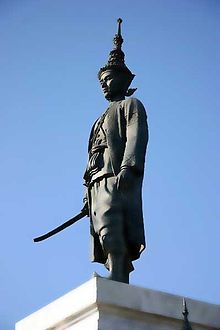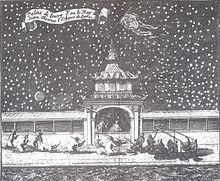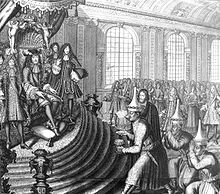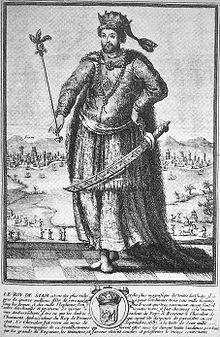- Narai
-
This article is about the Thai king. For the Japanese village of Narai, see Shiojiri, Nagano.
Narai the Great
สมเด็จพระนารายณ์มหาราชKing of Ayutthaya Statue of King Narai King of Siam Reign 26 August 1656 – 11 July 1688 Predecessor Suthammaracha (Sanpet IV) Successor Phetracha Issue Sudavadi, the Princess of Yodhadeb House Prasat Thong Dynasty Father King Prasat Thong Mother Princess Siri Galyani Born 1629 Died 11 July 1688
(aged c.58- 59)Somdet Phra Narai (Thai: สมเด็จพระนารายณ์มหาราช 1633 - 11 July 1688) or Somdet Phra Ramathibodi III (Thai: สมเด็จพระรามาธิบดีที่ 3) was the king of Ayutthaya from 1656 to 1688 and arguably the most famous Ayutthayan king. His reign was the most prosperous during the Ayutthaya period and saw the great commercial and diplomatic activities with foreign nations including the Persians and the West. During the later years of his reign, Narai gave his favorite – the Greek adventurer Constantine Phaulkon – so much power that Phaulkon technically became the chancellor of the state. Through the arrangements of Phaulkon, the Siamese kingdom came into close diplomatic relations with the court of Louis XIV and French soldiers and missionaries filled the Siamese aristocracy and defense. The dominance of French officials led to frictions between them and the native mandarins and led to the turbulent revolution of 1688 towards the end of his reign. Narai’s reign was also known for a small war with England in 1687 and the invasion of Burmese Lanna in 1662.
Nevertheless, the presence of numerous foreigners from the French Jesuits to the Persian delegates has left historians with rich sources of material on the city of Ayutthaya and its courtly life in the seventeenth century that otherwise would not have survived the complete destruction of the capital in 1767.
Contents
Succession
Prince Narai was born in 1633 to King Prasat Thong and his Queen Sirikalayani who was a daughter of Songtham. Prasat Thong had just usurped the throne from the ruling Sukhothai dynasty in 1629 and founded the dynasty of his own. Narai had an elder half-brother Prince Chai and an uncle Prince Sri Sudharmmaraja. Upon Prasat Thong’s death in 1656, Prince Chai succeeded his father as King Sanpet VI.
However, it was Thai tradition that gave brothers a higher priority over sons in succession. Prince Sudharmmaraja plotted with his nephew Prince Narai to bring Sanpet VI down. After nine months of ascension, Sanpet VI was executed in a coup. Narai and his uncle marched[1] into the palace and Sri Sudharmmaraja crowned himself king. Sri Sudharmmaraja appointed Narai as the Uparaja or the Front Palace. However, Narai himself was also an ambitious prince who had requested the Dutch for support against his uncle. Sri Sudharmmaraja’s rule was weak and he fell under the control of Chao Phraya Chakri – an ambitious mandarin who also wanted the throne himself.
In 1656, Narai and his uncle finally alienated each other. Sri Sudharmmaraja had affections of Narai’s sister Princess Rajakalayani. He ordered his soldiers to enclose her residence and himself invade the house. The princess hid in the book chest and was moved to the Front Palace were she met her brother.
Enraged at his uncle behavior, Prince Narai decided to take actions. Prince Narai drew his supports from the Persian and Japanese mercenaries that were largely persecuted during the reign of his father. Among the Siamese he got his brothers and the Okya Sukhothai as supporters. On the Day of Ashura the commemorating Persian army stormed the palace along with the Japanese. The prince engaged in personal battle with his uncle until the latter fled to the Rear Palace. Sri Sudharmmaraja was captured and was brought to execution at Wat Kok Phraya in October 1656.
Domestic Policy
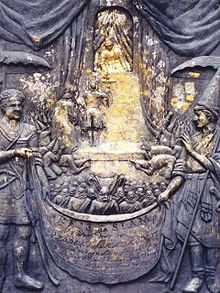 Memorial plate in Lopburi showing king Narai with French ambassadors.
Memorial plate in Lopburi showing king Narai with French ambassadors.
Domestic policies in King Narai's reign were greatly affected by the interference of foreign powers most notably the Chinese to the north, the Dutch to the South, and the English who were making their first forays into India to the west. Policies revolved around either directly countering the influence, or creating a delicate balance of power between the different parties.
Fearing a possible weakening of influence in the northern vassal states following the successful Chinese invasion of Ava in 1660, King Narai mounted an expedition to bring Chiang Mai under the direct control of Ayutthya. Although the expedition was successful in taking control of Lampang and other smaller cities, a second expedition had to be conducted to bring Chiang Mai under control.
There was also trouble on the Tenasserim coast at the port of Mergui. In July 1687, an incident that came to be known as the Mergui massacre occurred that resulted in the massacre of some sixty Englishmen. The incident had origins in a deterioration of the relationship between Siam and the East India Company. Phaulkon had appointed two English acquaintances of his as governors of Mergui, and they used the port as a base for privateering expeditions against the Kingdom of Golconda, which had friendly relations with the East India Company. In April 1687 the East India Company demanded £65,000 compensation from Narai and blockaded Mergui. Fearing a trial on the charge of piracy, the two English governors of Mergui lavishly entertained the captains of the ship. However, the entertainment aroused the suspicion of the Siamese authorities, who took matters into their own hands and opened fire on the English ships and massacred all the Englishmen they could lay their hands on. Narai then declared war on the East India Company, and handed control of Mergui over to a French governor and a small French garrison.[2] At the same time, he also granted a concession of the strategic port of Bangkok to France with the view of countering Dutch influence.[3]
King Narai also constructed a new palace at present-day Lopburi ("Louvo" in the French accounts) utilising the expertise of Jesuit architects and engineers. European influences are clearly evident in the architectural style, especially the use of wide windows. The move to Lopburi was arguably prompted by the Dutch naval blockade of Ayutthaya in 1664 to enforce a fur monopoly.
Although Catholic missions had been present in Ayutthaya as early as 1567 under Portuguese Dominicans, King Narai's reign saw the first concerted attempt to convert the monarch to Catholicism under the auspices of French Jesuits who were given permission to settle in Ayutthaya in 1662. The conversion attempt ultimately failed and arguably backfired but Catholics were to remain in Siam up to the present day.
Most controversially, King Narai allowed the rise of Constantine Phaulkon, a Greek adventurer who arrived in Ayutthaya in 1675. Within a few years, Phaulkon had managed to ingratiate himself with the king and became Narai's closest councillor. Under Phaulkon's guidance, King Narai balanced the influence of the Dutch by favouring the French. Phaulkon also encouraged French interest by initially leading them to believe that the king was about to convert to Catholicism. Although King Narai did display a degree of interest in Catholicism, he also displayed an equal interest in Islam and there is no concrete evidence that he wished to convert to either.[4] However, both Catholic and Islamic missions were to come to the conclusion that Phaulkon was responsible for their failures.[5][6] Siamese courtiers also resented Phaulkon's influence and he quickly became the focus of xenophobic sentiments at court, with the future King Phetracha at their head.
Foreign Missions
See also: France-Thailand relationsThe most remarkable aspect of King Narai's reign were the diplomatic missions that he sent and received during his reign. Missions were sent as far afield as France, England, and the Vatican, although at least two missions were lost at sea. Ties with states closer to Ayutthaya were not neglected as missions were also sent to Persia, Golconda (India), China, as well as other neighbouring states.
Undoubtedly, the most celebrated of these missions were those to Europe, in particular France. In 1673, a French ecclesiastical mission arrived at the Siamese court with letters from Pope Clement IX and King Louis XIV of France. King Narai reciprocated by sending a mission to France in 1680 led by Phya Pipatkosa.[7] Although the mission was lost at sea near Madagascar,[8] the French responded positively by sending a commercial mission to Ayutthaya headed by Monsignor Pallu in 1682.
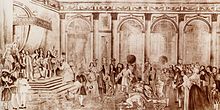 Kosa Pan presents King Narai's letter to Louis XIV at Versailles, 1 September 1686
Kosa Pan presents King Narai's letter to Louis XIV at Versailles, 1 September 1686
Rising French influence
The later half of Narai’s reign was the period of the growing French influence until the coup of 1688. This was achieved through a Greek adventurer with the Latinized name of Constantine Phaulkon who formerly worked for the English East India Company. Phaulkon was introduced into the court by Kosa Lek in 1681 as a witted interpreter and quickly gained the royal favor. In 1682 he served as the interpreter during the royal audience with François Pallu, who arrived with letters from Louis XIV. Phaulkon suggested his plan of the reconstruction of the fort of Mergui in polygonal European style, which was strongly opposed by Kosa Lek. Kosa Lek was found out receiving bribery from the peasants who did not want to be levied into the Mergui construction. He was beaten to death under royal orders.
Narai responded the French by the dispatch of Siamese mission to France in January 1684 led by Khun Pijaivanit and Khun Pijitmaitri accompanied by missionary Benigne Vachet. They reached Calais by November and eventually had the French royal audience. Louis XIV sent de Chaumont and de Choisy to lead the French mission in 1685 to return the Siamese embassadors and to convert Narai to Catholicism. The mission contained a large number of Jesuit priests and scientists. Colbert sent his letter to Phaulkon to instruct him to persuade the Siamese king to concede to French requests with the promises of knighting him as a count.
Though not convert to Christianity, Narai agreed to allow the French troops to be stationed in Siamese ports. Chevalier de Forbin was made the commander of Bangkok fort and trainers of Siamese armies in Western warfare. Several Siamese forts including Mergui, Ligor, Singora (Songkhla), Lavo, and Ayutthaya itself were reconstructed in European style. Another Siamese mission to France was led by Phra Visutsundhorn (Kosa Pan, younger brother of Kosa Lek) and Guy Tachard in 1686 with enthusiastic European reception. A fragmentary Siamese account of the mission compiled by Kosa Pan was re-discovered in Paris in the 1980s.[9]
Samuel White, the governor of Mergui fort and companion of Phaulkon, conflicted with the English fleets from India in 1687, leading to the English blockade of Mergui. The Siamese native mandarins massacred the local Englishmen out of frustration. With English fleets threatening Narai decided to denounce the English and executed the mandarins.
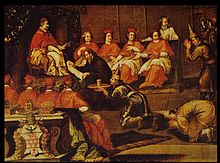 Pope Innocent XI receives the Siamese envoys, led by Father Tachard who reads the translation of the message from King Narai, December 1688
Pope Innocent XI receives the Siamese envoys, led by Father Tachard who reads the translation of the message from King Narai, December 1688
In March 1687 the new French mission left Brest for Ayutthaya. The mission includes Kosa Pan returning home, Guy Tachard again, Simon de La Loubère, Claude Céberet du Boullay, and the General Desfarges. The large number of French army and navy was sent with this mission to station in Siamese forts with Desfarges as the military commander. Narai agreed to station French troops at Mergui and Bangkok, both turned into a Western fort, with Desfarges at Bangkok. (The fort is now called the Vijaiprasit Fort Thai: ป้อมวิไชยประสิทธิ์ later the royal fort of King Taksin). The last Siamese embassy was led by Ok-khun Chamnan in 1688 visiting Rome and Pope Innocent XI.
The "Revolution" of 1688
Main article: Siamese revolution (1688)Narai spent his whole reign reducing the power of native mandarins that caused much bloodshed during his predecessors’ time. He firstly supported Persian and later the French guards and advisors against the Thai mandarins. Even his ascension to the throne was orchestrated by Persian mercenaries. The French eventually enjoyed special favors from religious affairs to the military activities. One of the critical turning points concerned with the construction of the French forts and military barracks in Bangkok, at the river mouth. In dealing with the activities, the French mostly depended on Constantin Phaulkon, the king's favorite. The threat of the French military presence, reportedly, was felt among the court noble. All in all, factionalism, favoritism and nepotism became apparent.
The native mandarin somehow managed to reserve their powers, most notably Kosa Lek. With the death of Kosa Lek, Petracha, the chief of the Royal Elephant Department, emerged as the leading native power. Petracha had familial connections to Narai, with his mother as the king’s milkmaid and his sister as the king’s concubine.
Narai is said to fear of fathering a son. He therefore ordered the abortion of any of his impregnated consorts. He, however, adopted a son of a minor mandarin with the name of Phra Piya and made him his successor. The young prince was embraced by the French who managed to convert him to Catholicism.
Matters were brought to a head when King Narai fell gravely ill in March 1688 while the king stayed in Lopburi palaces. Aware of the coming succession dispute, in May 1688 Narai called together his closest councillors: Phaulkon, Phra Phetracha, and Mom Pi and nominated his daughter, Kromluang Yothathep to succeed him. The three councillors were to act as regents until the princess took on a partner of her choice from one of the two Siamese councillors.[10] Far from calming the situation, Narai's decision spurred Phetracha to act. With Narai essentially incapacitated by his illness, Phetracha was given a free hand to usurp the throne with the support of a resentful court as well as the Buddhist clergy and ethnic-Persian mandarins. Mom Pi and Phaulkon were arrested and executed as Narai laid furious on his deathbed, unable to do anything to save his favourite.
On the death of King Narai, Phetracha proclaimed himself king, expelled the French and virtually severed all ties with the West.Siamese troops attacked the French troops at Bangkok fort, ending with the flee of the French. After an initial confinement, missionaries were allowed to continue their work in Ayutthaya under some restrictions. Contact between Siam and the West remained sporadic, and would not return to the level seen in the reign of King Narai until the reign of King Mongkut in the mid-nineteenth century.
Legacy
Although King Narai's reign witnessed the greatest extent of foreign influence at the Siamese court, his diplomatic achievements were to be reversed by his successor. It is debatable whether the new introspective attitude of his successors contributed to the weakening and eventual fall of Ayutthaya. On the other hand, the curtailing of foreign influences in the court may have prevented the colonisation of Ayutthaya. Nevertheless, his reign's diplomatic achievements contributed to him being posthumously styled "the Great," one of seven recognised as such in the history of Thailand.
At the same time, the records of those involved in the diplomatic missions, particularly those from the west, have allowed historians to obtain a rare glimpse into the world of the Ayutthayan court as most original Ayutthaya records were destroyed with the city in 1767. These include the French accounts of the Chevalier de Chaumont, the Abbé de Choisy, Fr. Tachard, Claude de Forbin, de la Loubere and the Persian account of Muhammad Rabi' ibn Muhammad Ibrahim. Domestically, the relative stability during his reign also gave rise to the revival of Siamese literature during his reign.[11]
Further afield, one of the main streets of the city of Brest as well as another in Marseilles have been named "Rue de Siam" to commemorate Narai's missions. In addition, among the gifts that were exchanged between the Siamese and the French courts, two items from Siam were to have an unexpected impact on French history. The items were a pair of silver cannons that were eventually stored in the Royal Furniture Repository in Paris since they were classed as gifts rather than weapons. After failing to find usable weapons at the Arsenal, rioting Parisians broke into the Repository and discovered some 20 cannons. However, the Siamese cannons were the only ones that still functioned, and so they were hauled to the Bastille. The date was 14 July 1789.[12]
See also
- France-Thailand relations
- Constantine Phaulkon
- Claude de Forbin
- François-Timoléon de Choisy
Notes
- ^ Wyatt, DK (1984). Thailand: A Short History. Chiang Mai: Silkworm. pp. 107.
- ^ Wyatt, DK. Thailand: A Short History. pp. 115.
- ^ Cruysse, Dirk van der (2002). Siam and the West. Chiang Mai: Silkworm. pp. 343.
- ^ Muhammad Rabi' ibn Muhammad Ibrahim; J. O'Kane (trans.) (1972). The Ship of Sulaiman. London: Routledge. pp. 98–9.
- ^ Muhammad Rabi'ibn Muhammad Ibrahim. The Ship of Sulaiman. pp. 59.
- ^ Cruysse, Dirk van der. Siam and the West. pp. 429.
- ^ "The Beginning of Relations with Buropean Nations and Japan (sic)". Thai Ministry of Foreign Affairs. 2006. http://www.mfa.go.th/web/117.php. Retrieved 2010-02-11.
- ^ Smithies, M (1999). A Siamese Embassy Lost in Africa, 1686. Chiang Mai: Silkworm. pp. 1.
- ^ Smithies, M.; Cruysse, Dirk van der (2002). The Diary of Kosa Pan: Thai Ambassador to France, June–July 1686. Seattle: University of Washington Press.
- ^ Cruysse, Dirk van der. Siam and the West. pp. 444.
- ^ Kings of Thailand
- ^ Carlyle, T., The French Revolution, Section V
References
- Cruysse, Dirk van der (2002). Siam and the West. Chiang Mai: Silkworm
- Marcinkowski, M. Ismail (2005). From Isfahan to Ayutthaya: Contacts between Iran and Siam in the 17th Century. With a foreword by Professor Ehsan Yarshater, Columbia University . Singapore: Pustaka Nasional
- Muhammad Rabi' ibn Muhammad Ibrahim, J. O'Kane (trans.) (1972). The Ship of Sulaiman. London: Routledge
- Smithies, M. (1999). A Siamese Embassy Lost in Africa, 1686. Chiang Mai: Silkworm
- Smithies, M., Bressan, L., (2001). Siam and the Vatican in the Seventeenth Century. Bangkok: River
- Smithies, M., Cruysse, Dirk van der (2002). The Diary of Kosa Pan: Thai Ambassador to France, June–July 1686. Seattle: University of Washington Press
- Wyatt, DK (1984). Thailand: A Short History. Chiang Mai: Silkworm
Preceded by
SuthammarachaKings of Ayutthaya
1656–1688Succeeded by
PhetrachaMonarchs of Thailand (List) Sukhothai Kingdom
(1238-1438)Sri Indraditya · Ban Muang · Ram Khamhaeng · Lerthai · Nguanamthom · Lithai · Leuthai · Saileuthai · Borommapan
Ayutthaya Kingdom
(1350-1767)Uthong · Ramesuan · Borommarachathirat I · Thong Lan · Rama Ratchathirat · Intha Racha · Borommarachathirat II · Trailokanat · Borommarachathirat III · Ramathibodi II · Borommarachathirat IV · Ratsadathirat · Chairacha · Yodfa · Worawongsathirat · Maha Chakkraphat · Mahinthrathirat · Maha Thammarachathirat · Naresuan · Ekathotsarot · Si Saowaphak · Songtham · Chetthathirat · Athittayawong · Prasat Thong · Chao Fa Chai · Si Suthammaracha · Narai · Phetracha · Suriyenthrathibodi · Thai Sa · Boromakot · Uthumphon · Ekkathat
Thonburi Kingdom
(1768-1782)Rattanakosin Kingdom, later Thailand
(1782-)Buddha Yodfa Chulalok · Buddha Loetla Nabhalai · Jessadabodindra · Mongkut · Chulalongkorn · Vajiravudh · Prajadhipok · Ananda Mahidol · Bhumibol Adulyadej (current)
Categories:- 1629 births
- 1688 deaths
- Thai monarchs
- Rulers of Ayutthaya
- Thai poets
Wikimedia Foundation. 2010.

